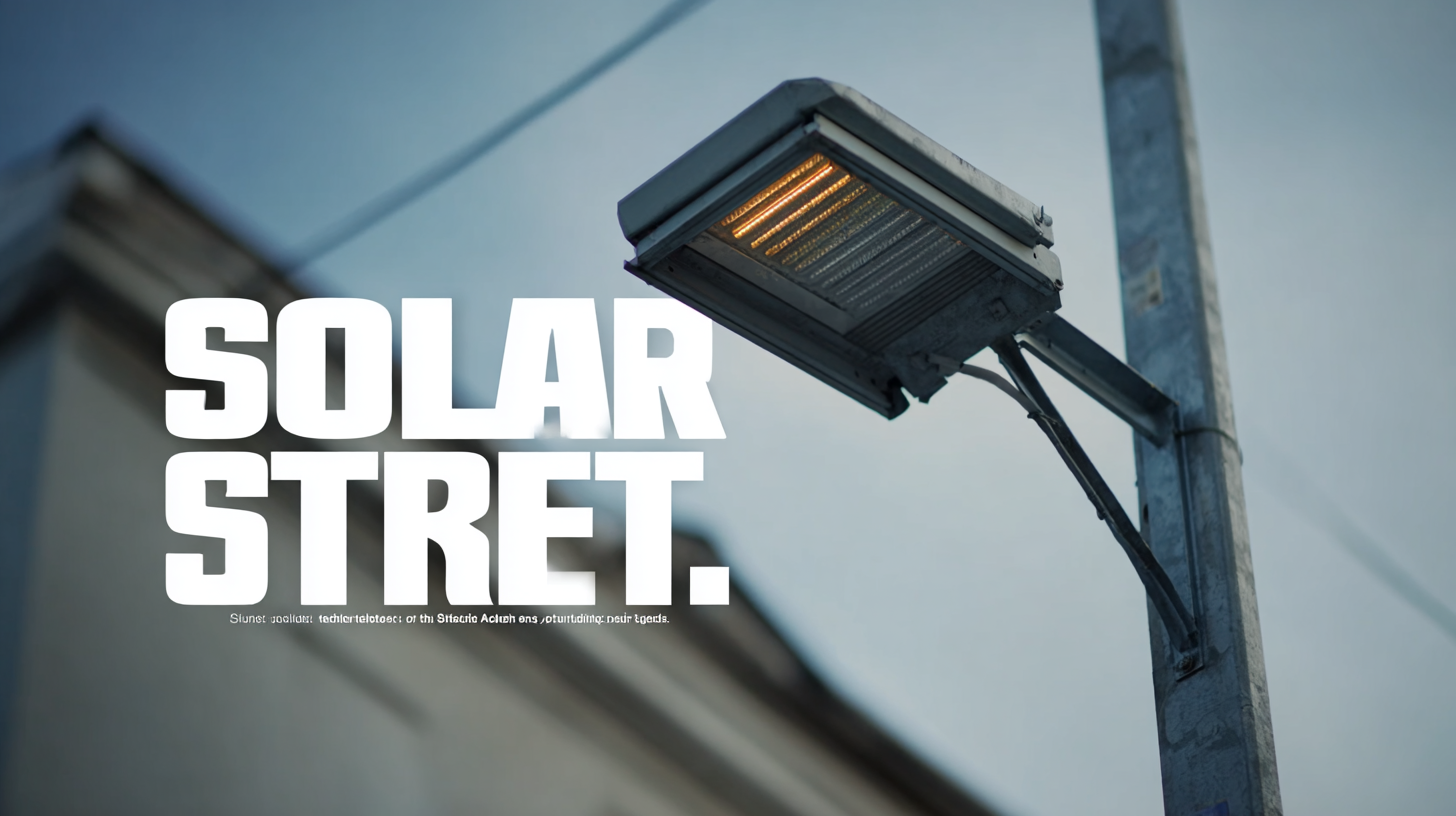Exploring Alternative Solar Street Light Options for Global Buyers
As cities around the globe continue to evolve towards sustainable energy solutions, Solar Street Light systems have emerged as an innovative alternative to traditional street lighting. With their energy-efficient designs and reduced carbon footprints, these lights not only illuminate public spaces but also play a significant role in enhancing urban aesthetics. However, selecting the right high-quality manufacturer is crucial for maximizing the benefits of solar street lighting.

In this blog post, we will explore various alternative solar street light options available for global buyers, guiding you through essential considerations and highlighting the best types of solar street lights suited for different applications. Join us as we delve into the manufacturing landscape, examining what makes a provider stand out in this growing market, and equipping you with the knowledge to make informed purchasing decisions.
Emerging Solar Technologies Revolutionizing Street Lighting by 2025
As cities around the globe strive for sustainability, emerging solar technologies are set to revolutionize street lighting by 2025. These advancements are not just enhancing energy efficiency but are also providing innovative solutions to urban challenges. Solar street lights equipped with smart sensors and connectivity features can adapt to environmental changes, ensuring optimal illumination while conserving energy. By integrating this technology, municipalities can significantly reduce operational costs while simultaneously decreasing their carbon footprint.
Moreover, the latest solar street light designs harness high-efficiency photovoltaic cells and energy storage systems, enabling them to work effectively even in areas with limited sunlight. This adaptability makes solar street lights an ideal choice for diverse environments, expanding accessibility in both urban and rural settings. With the ongoing developments in battery technology, these systems are becoming increasingly reliable, promising longer operational hours and enhanced durability, which are crucial for public safety and urban aesthetics. As these solar innovations gain traction, their widespread implementation will herald a new era of environmentally conscious urban infrastructure.
Emerging Solar Street Light Technologies by 2025
This bar chart illustrates the projected adoption rates of various alternative solar street light technologies by 2025. The data highlights the increasing preference for advanced solar solutions among global buyers.
Comparative Analysis of Solar Street Light Efficiencies: Traditional vs. New Innovations
When exploring solar street light options, it's essential to understand the efficiency differences between traditional models and newer innovations. Traditional solar street lights often rely on older solar panel technology, which may not harness sunlight as effectively, leading to inconsistent performance and limited illumination during the night. These systems typically incorporate sealed lead-acid batteries, which, while cost-effective, have a shorter lifespan and lower energy capacities, frequently necessitating replacements and incurring ongoing maintenance costs.

In contrast, new innovations in solar street lighting have embraced advancements such as monocrystalline solar panels and lithium-ion batteries. These components significantly enhance energy absorption and storage, extending operational hours and increasing overall luminance. Many of these modern systems feature smart technology, including adaptive lighting and real-time monitoring, which optimize energy usage and extend battery life even further.
Comparing the efficiencies of these two approaches reveals that investing in innovative solar street lights not only improves lighting quality but also offers long-term cost savings for cities and organizations looking to enhance their sustainability efforts.
Cost-Benefit Analysis of Implementing Alternative Solar Street Light Solutions Globally
As cities around the world seek sustainable solutions to urban lighting challenges, alternative solar street light options present a transformative opportunity. Conducting a cost-benefit analysis of implementing these systems reveals that the initial investment in solar street lights can lead to significant long-term savings. These lights operate independently of the grid, drastically reducing electricity expenses and maintenance costs over time. By harnessing renewable energy, municipalities can decrease their carbon footprints and promote a greener image that appeals to eco-conscious citizens and businesses.
Moreover, alternative solar street lights come in various designs and functionalities, offering cities the flexibility to choose systems that best meet their unique requirements. Advanced features such as smart technology integration can enhance their efficiency, providing not only illumination but also data collection capabilities. This adaptability can further justify the upfront costs as cities evaluate the potential return on investment over the lifespan of the lighting solutions. As global buyers explore these options, it is essential to weigh both the tangible financial metrics and the broader impact on community well-being and environmental sustainability.

Impact of Renewable Energy Policies on Solar Street Light Adoption Rates Worldwide
The rise of renewable energy policies across the globe has significantly influenced the adoption rates of solar street lights. According to a report by the International Renewable Energy Agency (IRENA), countries with supportive policies in place have reported a 20-30% increase in solar street light installations over the past five years. This trend is particularly evident in regions where energy costs are high, and governments are incentivizing the transition to renewable sources. For example, India’s solar power policy targets 100,000 solar street lights across rural and urban areas, reflecting a national commitment to sustainable development.
Additionally, the Global Solar Street Light Market is projected to reach $13.8 billion by 2026, driven in part by favorable government regulations and funding initiatives. Research by MarketsandMarkets highlights that regions like Africa and Southeast Asia have seen accelerated growth in solar street light installations, thanks to various government grants and international assistance programs aimed at enhancing energy access. As nations prioritize environmentally friendly solutions, the interplay of renewable energy policies and technological advancements will continue to shape the landscape of solar street light adoption worldwide.
Exploring Alternative Solar Street Light Options for Global Buyers
| Region | Adoption Rate (%) | Policy Influence Level | Average Cost per Unit (USD) | Renewable Energy Target (by 2030) |
|---|---|---|---|---|
| North America | 35% | High | 1500 | 50% |
| Europe | 50% | Very High | 1200 | 75% |
| Asia | 25% | Moderate | 800 | 40% |
| Africa | 15% | Low | 600 | 35% |
| Latin America | 20% | Moderate | 700 | 45% |
Future Trends in Solar Battery Storage for Enhanced Street Lighting Solutions
As the demand for sustainable urban infrastructure grows, the integration of advanced solar battery storage solutions in street lighting is becoming increasingly vital. These innovations not only enhance energy efficiency but also ensure consistent performance during nighttime or cloudy days. Future trends in solar battery technology indicate a shift towards longer-lasting, higher-capacity batteries that can store more energy for extended use. Investing in lithium-ion or advanced lead-acid batteries can provide municipalities with reliable lighting, reducing the dependency on grid electricity and lowering operational costs.
Tip: When considering solar street lighting systems, prioritize batteries with a longer cycle life and fast charging capabilities. This will extend the overall lifespan of your lighting system and improve energy resilience.
Moreover, the emergence of smart technology in battery storage is paving the way for enhanced monitoring and control. By integrating IoT solutions, cities can optimize power usage, track battery health, and manage energy consumption in real-time. This adaptability not only improves user experience but also allows for better maintenance and performance assessments over time.
Tip: Implementing a monitoring system can help identify potential issues early on, ensuring that street lights are functioning optimally and minimizing downtime.
